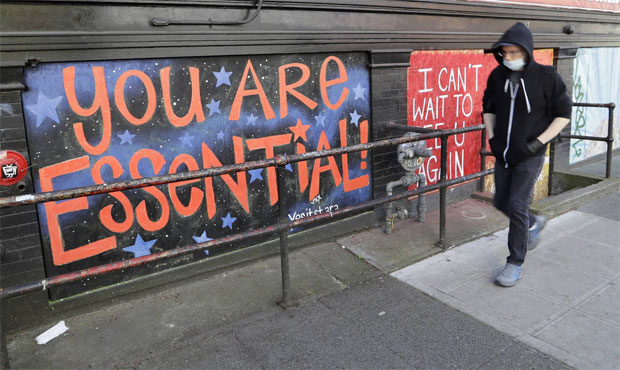Washington businesses won’t be hit with unemployment solvency tax
Oct 1, 2020, 5:47 AM | Updated: 10:45 am

Artwork painted on plywood covering a downtown Seattle business closed during the lockdown this past spring. (AP Photo/Elaine Thompson)
(AP Photo/Elaine Thompson)
Washington state’s unemployment system has rarely been associated with good news in recent months, plagued by everything from thieves to a massive backlog, not to mention the large depletion of the unemployment trust fund caused by widespread layoffs.
That depleted trust fund was in solid shape pre-COVID with a $4.6 billion balance at the end of March. But by mid-June, so many people were getting unemployment benefits, the fund’s ending balance was already down to $3.13 billion. The Employment Security Department (ESD) projections expected the fund to be insolvent by the end of 2020.
It also projected that, as a result, Washington’s trust fund would need to rely on a federal trust fund loan in the final months of 2020 to bolster fund balances and ensure interruption in payment of UI benefits is not interrupted, and impose a solvency tax on employers.
Ahead of Thursday’s release of the full September quarterly Unemployment Insurance Trust Fund Forecast, the ESD announced things were looking up.
“There will not be a solvency tax for employers in 2021, a savings for businesses of nearly $200 million, based on a higher than expected unemployment trust fund balance at the end of September,” according to a press release from ESD.
“At this time, due to improved economic forecasting, it is also projected that the state will not need to take out federal loans to continue paying unemployment benefits in 2021 as had been previously reported,” continued the statement.
The 0.2% solvency tax is triggered by state law whenever the trust fund balance for unemployment drops below the amount needed to cover seven months of benefits. If it was imposed, it would have cost businesses in Washington nearly $200 million, according to the ESD.
Washingtonians still waiting on unemployment checks
The ESD has not said what the ending balance of the trust fund was Wednesday, only that it was enough to cover the requisite seven months of benefits. That marked a much-needed opportunity to share some positive news for ESD Commissioner Suzi LeVine.
“This is great news for employers and businesses in Washington,” LeVine said. “Having one of the nation’s strongest unemployment trust funds is helping us weather this crisis better than many states. Coupled with a stronger than expected state revenue forecast last week, this means an improved outlook overall and a break for employers when they most need it.”
You can read the full statement from the ESD .
The rescue from a new tax on already struggling business owners does not mean those employers won’t take a hit from the mass layoffs and benefits being paid out, though. Unemployment taxes paid by employers are all dictated by state law. The rates businesses pay depend on a couple of things.
in June projected increases in employer taxes starting in 2021 that remain significantly elevated through 2025. That included the solvency tax, and the two parts of the everyday unemployment taxes paid by employers: the experience based tax and a social cost tax.
The individualized experience tax is based on the average annual benefits paid by a specific employer to workers during the prior four years, which, for 2021, would be the period between July 1, 2016, and June 30, 2020, which includes four months of benefits paid since the onset of COVID-related layoffs.
The social cost tax is for unemployment costs that can’t be collected by a single employer and is shared by all employers. This is expected to be a maxed-out flat rate of 1.22% in 2021 and 2022, up from 0.25% in 2020.
The combined tax rate, levied on a portion of a company’s payroll, varies, averaging 0.91% in 2020. That average of around 1% percent was expected to continue before the pandemic, but the June forecast projected it would jump to an average rate that peaks around 2.74% in 2022 before gradually falling.
Even if the forecast released Thursday is significantly improved, it will not impact the experience and social taxes as it did the solvency tax, which, unlike the other two, is triggered when needed and is not constant.
In earlier this month to the Unemployment Insurance advisory Committee, the ESD’s Employment System Policy Director, Dan Zeitlin, highlighted the situation and the options for trying to lessen the blow to employers, seen as vital for states working to fast track their economic recovery.
On the experience rate tax:
- The experience rate tax is an annual tax calculation based on the ratio of benefit claims charged to the employer and “taxable wages” reported by the employer over the preceding four fiscal years.
- Experience tax rates for 2021 will be based upon the experience rating between July 2016 through June of 2020.
- The UI trust fund balance has no impact on the experience rate tax.
- Changes to the employer experience tax rate would require the legislature to amend state statute (RCW 50.29.025). Lowering experience rate taxes would reduce UI taxes for employers and revenue into the trust fund.
On the social cost tax:
- Increased monies into the trust fund will not impact social tax rates without the Legislature taking action.
- In 2010, under similar circumstances, the legislature enacted the 1.22% flat social tax ceiling.
Amending a state statute to lower the social tax rate would reduce UI taxes for employers and revenue into the trust fund.
It is possible the Legislature will consider some of those changes, and the state has already to help employers. For now, the one thing that is certain is that the forecast being released Thursday will reflect less tax on employers than the previous one in June, because it will not include the solvency tax for 2021.














